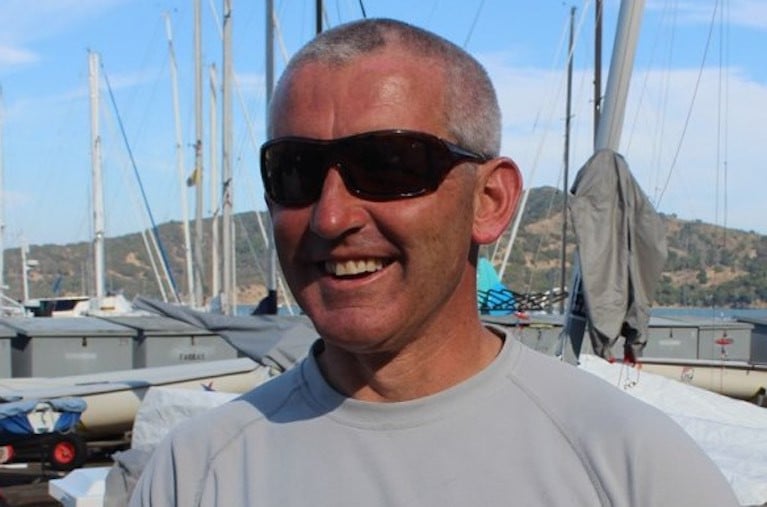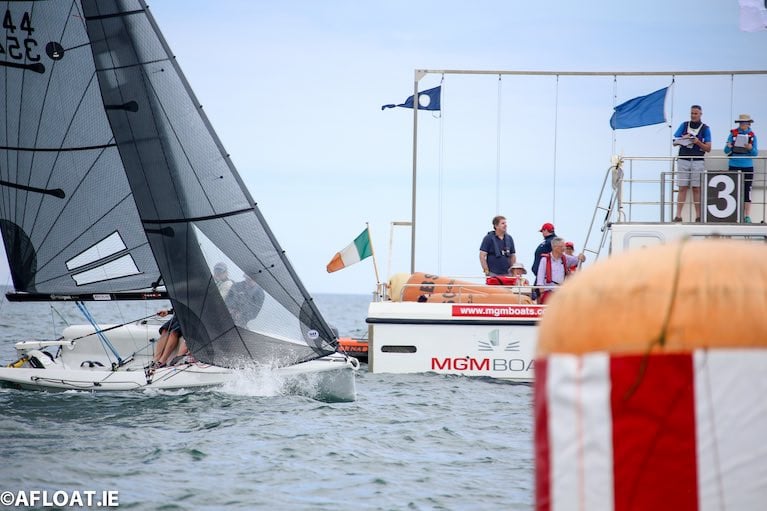Displaying items by tag: Royal Irish Yacht Club
Howth Yacht Club's 'Insider' Leads at the Sigma 33 National Championships at the Royal Irish Yacht Club
Visitors occupy the top three places overall after three races sailed at the 2021 Sigma 33 Irish Championships at the Royal Irish Yacht Club in Dun Laoghaire Harbour.
Howth Yacht Club's 'Insider' co-skippered by Stephen Mullaney and Ian Martin leads the nine boat fleet by three points from Waterford Harbour's Flyover (Marchant Roche McDonald) on seven points.
Third is former class champion Squawk skippered by Paul Prentice of Ballyholme Yacht Club.
Up to seven clubs are represented in the nine boat fleet bringing visitors from Ballyholme Yacht Club in Belfast Lough to Dunmore East Harbour on the south coast to Dublin Bay.
Results are here.
Racing continues today.
Consistent sailing with two race wins and five results in the top three gave the Beneteau 211 National Championships title to Peter Carroll's Yikes! at the Royal Irish Yacht Club this afternoon.
John Downey's B211 Capilano closed the gap by a point in today's final two races on Yikes to finish just one point adrift in second overall on seven points.
15-20 knot south easterly breezes proved to be testing championship conditions for the 12-boat fleet in a good chop, though the sheltered Seapoint racecourse protected the 20-foot keelboat class from the bigger waves on the Bay.
 John Downey's B211 Capilano
John Downey's B211 Capilano
Third in the 11-boat fleet was Andrew Bradley's Chinook on 13 points.
 Andrew Bradley's B211 Chinook
Andrew Bradley's B211 Chinook
Results are here
Beneteau 211 National Championships Photo Gallery
Clear Victory for SB20 'Ted' Crew at Royal Irish Yacht Club Hosted Eastern Championships
Six straight wins handed the SB20 Eastern Championships title to Ted crew, Michael O'Connor, Davy Taylor and John O'Driscoll at the Royal Irish Yacht Club this afternoon.
15-20 knot south easterly breezes proved to be testing championship conditions for the 12-boat fleet in a good chop, though the sheltered Seapoint racecourse protected the 20-foot keelboat class from the bigger waves on the Bay.
In the fight for second place overall, the National Yacht Club's Philip, Simon and Paul Doran leapfrogged Royal Cork's Mel Collins and Aidan Mac Sweeny in Gold Digger (in second place overnight) and Royal Irish's Ger Dempsey and Chris Nolan on the final day to take second by a single point from Dempsey who took third overall.
As regular Afloat readers will know, the Irish SB20 fleet is gearing up for next year's world championships on Dublin Bay, a year earlier than originally planned.
It's a change that also sees the Irish hosted World Championships switching venues at Dun Laoghaire. The event now moves from the National Yacht Club to the Royal Irish Yacht Club, which is hosting this weekend's Eastern Championships as part of its world's build-up.
Results are here.
SB20 Easterns Photo Gallery
Peter Carroll's 'Yikes' Leads Beneteau 211 National Championships at the Royal Irish Yacht Club
The host club dominates the 2021 Beneteau 211 National Championships at the Royal Irish Yacht Club after the first three races sailed off Dun Laoghaire Harbour.
With a 2,1,1 scored so far RIYC's Peter Carroll helming Yikes has a three-point margin over clubmate John Downey's Capilano on seven points.
Royal Irish commodore Pat Shannon, sailing Beeswing, is lying third on 13 points in the 11-boat fleet.
 A start of a 2021 Beneteau 211 National Championships race at Dun Laoghaire
A start of a 2021 Beneteau 211 National Championships race at Dun Laoghaire
Dublin Bay presented 12 to 18-knot breezes from the southeast with a mist and fine drizzle.
Testing championship conditions for the 12-boat fleet were completed with a good chop, though the sheltered Seapoint racecourse protected the 20-foot keelboat class from the bigger waves on the Bay.
Racing continues on Sunday.
Results are here.
SB20 Champions O'Connor, Taylor & O'Driscoll Take the Lead at the Royal Irish Hosted Easterns
Michael O'Connor, Davy Taylor and John O'Driscoll lead the 2021 SB20 East Coast Championships by eight points after three races sailed off Dun Laoghaire Harbour.
Dublin Bay presented 12 to 18-knot breezes from the southeast with a mist and fine drizzle.
Testing championship conditions for the 12-boat fleet were completed with a good chop, though the sheltered Seapoint racecourse protected the 20-foot keelboat class from the bigger waves on the Bay.
 Michael O'Connor, Davy Taylor and John O'Driscoll lead the 2021 SB20 East Coast Championships off Dun Laoghaire Photo: Afloat
Michael O'Connor, Davy Taylor and John O'Driscoll lead the 2021 SB20 East Coast Championships off Dun Laoghaire Photo: Afloat
The Dublin trio is well clear of Royal Cork's Mel Collins and Aidan Mac Sweeny in Gold Digger who is just one point ahead of Royal Irish's Ger Dempsey and Chris Nolan in third place on 12 points.
As regular Afloat readers will know, the Irish SB20 fleet is gearing up for next year's world championships on Dublin Bay, a year earlier than originally planned.
It's a change that also sees the Irish hosted World Championships switching venues at Dun Laoghaire. The event now moves from the National Yacht Club to the Royal Irish Yacht Club, which is hosting this weekend's Eastern Championships as part of its world's build-up.
Racing continues on Sunday.
Results are here.
Royal Irish Yacht Club Dun Laoghaire Dingle Champion Rockabill VI is Aiming for a Hat Trick
As well as the defending champion, Dun Laoghaire's Royal Irish Yacht Club will have three other yachts in Wednesday's Dun Laoghaire to Dingle Race.
The 14th edition of the 280-mile offshore fixture starts at 2 pm off Dun Laoghaire Harbour and is organised by the National Yacht Club.
Paul O'Higgins will defend his D2D crown in the JPK 10.80 Rockabill VI and aim to make it three in a row for the RIYC after previous Rockabill VI victories in 2017 and 2019.
The champion is joined by some potent RIYC clubmates; Andrew Algeo's J99 Juggerknot II, the Beneteau First 40 Prima Forte as well as George Sisk's Xp 44, WOW.
 Patrick Burke and Sean Lemass's First 40, Prima Forte
Patrick Burke and Sean Lemass's First 40, Prima Forte
Patrick Burke and Sean Lemass's First 40 arrived in Dublin Bay in January last year and in her first season won DBSC's best performing new yacht award. As regular Afloat readers will know, this all-round performer was previously named La Response, and before that formerly known as Courier Zen and a veteran of several Commodore's Cup teams under former owner Andrew McIrvine, an ex Admiral and Commodore of the Royal Ocean Racing Club.
 Andrew Algeo's J99 Juggerknot II
Andrew Algeo's J99 Juggerknot II
Algeo's Juggerknot II crew, who finished eighth in the 2019 race, is joined for this edition by Figaro campaigner Kenny Rumball.
 George Sisk’s Xp 44 Wow
George Sisk’s Xp 44 Wow
George Sisk’s Xp 44 “Wow” was the 2019 Sovereign’s Cup winner in the coastal class, having delivered a hat-trick of wins and beating bigger sistership the Xp 50 Freya on her home waters off Kinsale in the Regatta’s Coastal Class but was scored as 'did not finish' in that year's D2D.
A fourth Royal Irish boat, Barry Cunningham's Sun Odyssey 490, ConQuestador is contesting the IRC Cruiser class.
Royal Irish Yachts in the 2021 Dun Laoghaire to Dingle Race
- ConQuestador Jeanneau Sun Odyssey 490, IRL4900, Skipper: Barry Cunningham, Class: IRC Cruiser, Rating: 1.079
- Juggerknot II J/99, IRL 3990, Skipper: Andrew Algeo, Class: IRC Racing, Rating: 1.011
- Rockabill VI JPK 10.80, IRL 10800, Skipper: Paul O'Higgins, Class: IRC Racing, Rating: 1.05
- WOW X-Yachts Xp44, IRLl4419, Skipper: George Sisk, Class: IRC Racing, Rating: 1.124
- Prima Forte Beneteau, IRL4240, Skipper: Sean Lemass, Class: IRC Racing, Rating: 1.078
Dun Laoghaire Sportsboat Cup Postponed Til 2022
The Royal Irish Yacht Club at Dun Laoghaire Habour has announced it is 'sadly' postponing its planned May Dun Laoghaire Cup till 2022 due to the ongoing COVID-19 restrictions.
Regatta organiser David Ryan told Afloat 'We thank the sailors for their continued support and look forward to seeing everyone in 2022".
Enda O’Coineen's RIYC Talk on 'Across the Atlantic by Inflatable & Other Ways to Get Wet'
The Royal Irish Yacht Club's 'Home Together' virtual talk this Thursday 4th February will feature RIYC member Enda O’Coineen.
Enda will recount the extraordinary story of his epic transatlantic solo voyage onboard his 16-foot inflatable, the Kilcullen just over 35 years ago.
Having first made landfall in Dunmore East, upon arriving finally in Dun Laoghaire, Enda promptly sold the Kilcullen. It subsequently changed hands several times before Enda finally bought her back and restored her, reviving memories of some extraordinary adventures, long submerged and almost deliberately forgotten.
 The refurbished 5m Humber RIB in which Enda ‘OCoineen crossed the Atlantic in 1985
The refurbished 5m Humber RIB in which Enda ‘OCoineen crossed the Atlantic in 1985
Enda first attempted to cross the Atlantic by inflatable at the age of 22 and almost making it before capsizing off the west coast of Ireland – and being rescued by the NATO war fleet.
Seven years later Enda attempted the voyage for a second time and this time made-it into the record books.
Commences 19:30hrs contact [email protected] to register.
Full House for Prof’s Top Ten Dublin Bay Racing Tips at Royal Irish Yacht Club Webinar
North Sails Ireland’s Maurice “Prof” O’Connell’s top ten tips talk to RIYC Members and guests pulled in the crowds with a record-breaking 105 attending.
Prof’s insights for racing in Dublin Bay ranged on how to gain maximum advantage through adequate preparation before going afloat, through to the start line to sail trim principles/set-up and key boat handling manoeuvres for rounding marks.
Prof brought the audience through Dublin Bay geography and topography, the DBSC course card design, logic, mark locations and geometry as well as Dublin Bay currents.
He talked through the importance of correct onboard communications and providing clear information fundamental to sailing the correct course.
Prof, who never misses a DBSC race with his customers unless he is out of the country, concluded with “Rules of Thumb” for Dublin Bay racers. The talk was part of the RIYC “Home Together” series of virtual talks.
Royal Irish Yacht Club's Home Together Series “Winning Races in Dublin Bay" - Top Tips from North Sails Ireland's Prof O'Connell
The Royal Irish Yacht Club's successful 'Home Together' series of virtual talks returns this Wednesday 27th January at 19:30hrs with Maurice “Prof” O’Connell.
O'Connell from North Sails Ireland never misses a Dublin Bay Sailing Club (DBSC) race with his customers unless he is out of the country.
Over the years, he has raced in 100's of DBSC races in everything from the biggest IRC Cruiser 0 yachts to the smaller one-designs. He has put together his "10 Top Tips for racing in Dublin Bay" which he will share with RIYC members and guests.
Commences 19:30hrs contact [email protected] to register.
Across the Atlantic by Inflatable & Other Ways to Get Wet with Enda O’Coineen
On Thursday, 4th February Enda O’Coineen reprises memories of his epic transatlantic solo voyage onboard his 16-foot inflatable, the Kilcullen just over 35 years ago.
Having first made landfall in Dunmore East, upon arriving finally in Dun Laoghaire, Enda promptly sold the Kilcullen. It subsequently changed hands several times before Enda finally bought her back and restored her, reviving memories of some extraordinary adventures, long submerged and almost deliberately forgotten.
Commences 19:30hrs contact [email protected] to register.































































